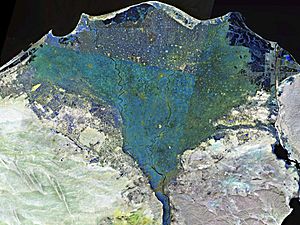365 Crete earthquake facts for kids
| Local date | 21 July 365 |
|---|---|
| Local time | Sunrise |
| Magnitude | Mw 8.5+ |
| Epicenter | near Crete 35°00′N 23°00′E / 35.0°N 23.0°E |
| Fault | Unknown (HSZ) |
| Areas affected | Mediterranean Basin |
| Max. intensity | XI (Extreme) |
| Tsunami | Yes |
| Casualties | "Many thousands" |
The 365 Crete earthquake was a massive earthquake that happened around sunrise on July 21, 365 AD. Its center was likely near the island of Crete in the eastern Mediterranean Sea. Scientists believe this underwater quake was very powerful, measuring 8.5 or even higher on the Moment magnitude scale.
This huge earthquake caused a lot of damage across a wide area. It destroyed many places in modern-day Greece, northern Libya, Egypt, Cyprus, Sicily, and Spain. On Crete itself, almost every town was ruined.
After the earthquake, a giant tsunami (a series of huge ocean waves) hit the southern and eastern coasts of the Mediterranean. Areas like Libya, Alexandria, and the Nile Delta were badly affected. Thousands of people died, and the waves carried ships up to 3 kilometers (about 2 miles) inland. This event was so memorable that writers from that time often mentioned it in their works.
Contents
How the Earth Moved: Geological Clues
Scientists have studied the 365 Crete earthquake by looking at the Earth's geology. They believe it was part of a time when many big earthquakes happened in the Eastern Mediterranean between the 300s and 500s AD. This might mean that the major tectonic plate boundaries in the area became active again.
The earthquake is thought to have lifted parts of the island of Crete by about 9 meters (nearly 30 feet)! This huge movement shows how powerful the earthquake was. It was much stronger than any other earthquake known in the region in modern times.
By studying ancient corals on the coast of Crete, scientists found that they were suddenly pushed up 10 meters (about 33 feet) out of the water. This proves that the tsunami was caused by an earthquake along a steep fault line in the Hellenic Trench near Crete. Experts say an uplift this big probably only happens once every 5,000 years. However, other parts of the same fault could move in a similar way, which might happen every 800 years or so.
Ancient Stories: What Writers Said

Historians still discuss whether ancient writers were talking about just one huge earthquake in 365 AD, or if they combined stories of several earthquakes that happened between 350 and 450 AD. It's tricky to understand these old writings because people back then often saw natural disasters as messages or warnings from their gods.
For example, some writers who supported Christianity or paganism at the time might have made the earthquake seem worse. They did this to show it was either a sign of sadness or anger from their gods about the death of Emperor Julian, who had tried to bring back the pagan religion a few years earlier.
Even with these different viewpoints, the many mentions of earthquakes from that time suggest there was indeed a period of increased seismic activity. For instance, the city of Kourion on Cyprus was hit by five strong earthquakes in 80 years, which eventually destroyed it completely.
Digging Up the Past: Archeological Finds
Archeologists have found strong evidence of the 365 earthquake's destructive power. When they dig up ancient towns and cities in the Eastern and Southern Mediterranean, they often find signs of widespread destruction around the year 365 AD. This shows how many places were ruined by this single event.
The Giant Wave: The Tsunami's Impact
A Roman historian named Ammianus Marcellinus wrote a detailed description of the tsunami that hit Alexandria and other places early on July 21, 365 AD. His account is special because it clearly explains the three main parts of a tsunami: first, the earthquake; second, the sea suddenly pulling back; and third, a huge wave rushing onto the land.
He wrote that after sunrise, the ground shook violently. Then, the sea pulled back, showing the deep ocean floor and sea creatures stuck in the mud. Many ships were left stranded on what looked like dry land. People even walked out to collect fish. But then, the sea roared back. It crashed onto islands and large areas of land, destroying countless buildings.
The returning water drowned thousands of people. Some ships sank, and the bodies of those who died in shipwrecks floated in the water. Other huge ships were thrown onto the roofs of houses, like in Alexandria. Some were even hurled nearly two miles from the shore, such as a ship he saw near the town of Methone.
The tsunami in 365 was so terrible that people in Alexandria remembered it every year. They called the anniversary a "day of horror" even at the end of the 500s AD.
Gallery
Effects of the earthquake visible in the ancient remains:
See also
- 426 BC Malian Gulf tsunami
- List of earthquakes in Greece
- List of historical earthquakes
- List of tsunamis







